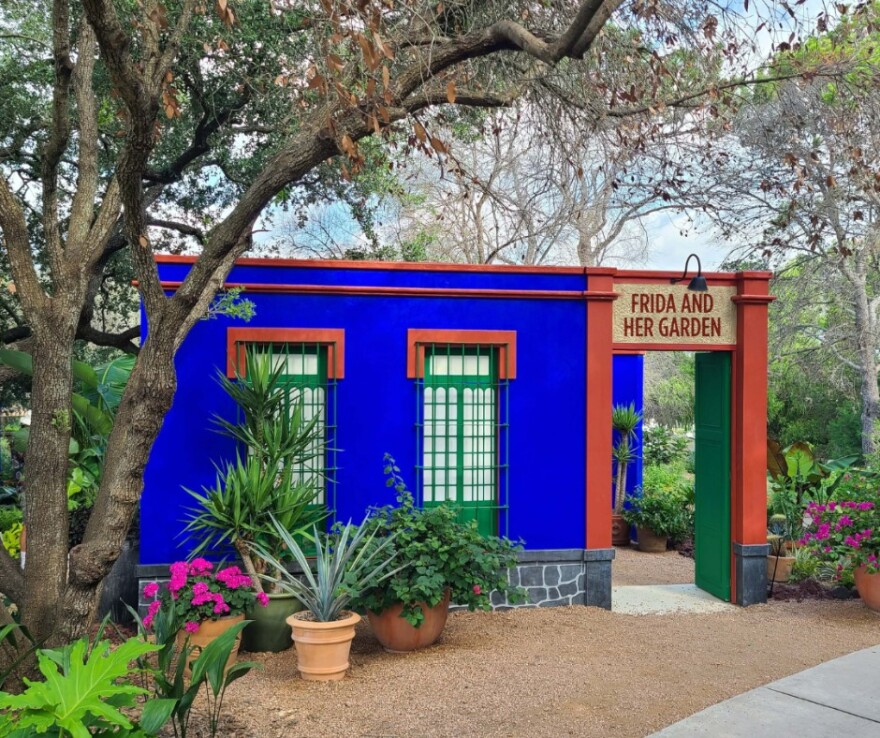Naples Botanical Garden spent a year transforming a previously inaccessible portion of its property into an exhibition running through the summer that captures the tranquility of La Casa Azul, the residence of Mexican painter Frida Kahlo, who not only inspired a generation of artists but is a role model for norm-defying women.
The exhibit, “Frida and Her Garden,” is tucked amid tropical foliage similar to the flora Kahlo featured in her work. La Casa Azul, which means The Blue House, was the artist’s refuge during a tumultuous marriage with husband and Mexican muralist, Diego Rivera, and a life wracked by pain.
Kahlo (1907 – 1954) is known for her self-portraits and her unique, vibrant style. She grew up in a politically active family in Mexico and was interested in art from an early age. However, she nearly died in a bus accident in her teens in 1925 and the crash left her bedridden for months and caused her significant pain for the rest of her life. It was during her recovery that she started painting, as a way to pass the time and cope with her injuries.
She endured nearly 30 operations and used a wheelchair for much of her life. But she found beauty in the natural world, and that is the spirit “Frida and Her Garden” celebrates.
Despite being confined to a bed or a wheelchair for long periods of time, Frida's paintings are filled with vivid colors and intricate details, showcasing her strength and determination.
Kahlo’s self-portraits, in particular, depict her struggles with illness, infertility, and her relationship with her famous muralist husband, Diego Rivera.
One of her most famous paintings is “The Broken Column,” which is an oil-on-Masonite depiction of her experience in 1944 after she had spinal surgery to correct on-going medical problems from the traffic accident.
Kahlo’s art was also heavily influenced by Mexican folk art and culture, and she incorporated traditional symbols, such as flowers and animals, into her paintings. A stalwart feminist icon, her paintings often challenged the expectations and limitations placed on women in Mexican society.
He style has been called bold and unapologetic, and her refusal to conform to traditional gender roles made her an inspiration to countless women and artists still today and source of strength for anyone who has faced injury and disability.
"Frida and Her Garden” is the centerpiece of the botanical garden’s season, which is called “Mexico: A Celebration of Plants & Culture,” which highlights one of the most biodiverse counties on the planet and celebrates cultural connections to the natural world.
“Frida and Her Garden” includes sculptural pieces such as La Casa Azul’s iconic façade and a replica of the stepped pyramid Kahlo and Rivera used to display their collection of pre-Hispanic figures. It features garden beds showcasing plants from Kahlo’s paintings, those that are native to Mexico, and those that are reminiscent of Kahlo and Rivera’s life together.
In addition, six animal sculptures are located throughout the garden, depicting creatures dear to her, including a parrot and a butterfly. Their varying styles reflect her love of indigenous art and Mexican folk art.
Naples Botanical Garden is at 4820 Bayshore Dr., Naples, FL 34112. It is open every day from 9 a.m. to 5 p.m., and 8 a.m. for members. Tickets are $15. For more information, call (239) 643-7275.
WGCU is your trusted source for news and information in Southwest Florida. We are a nonprofit public service, and your support is more critical than ever. Keep public media strong and donate now. Thank you.








